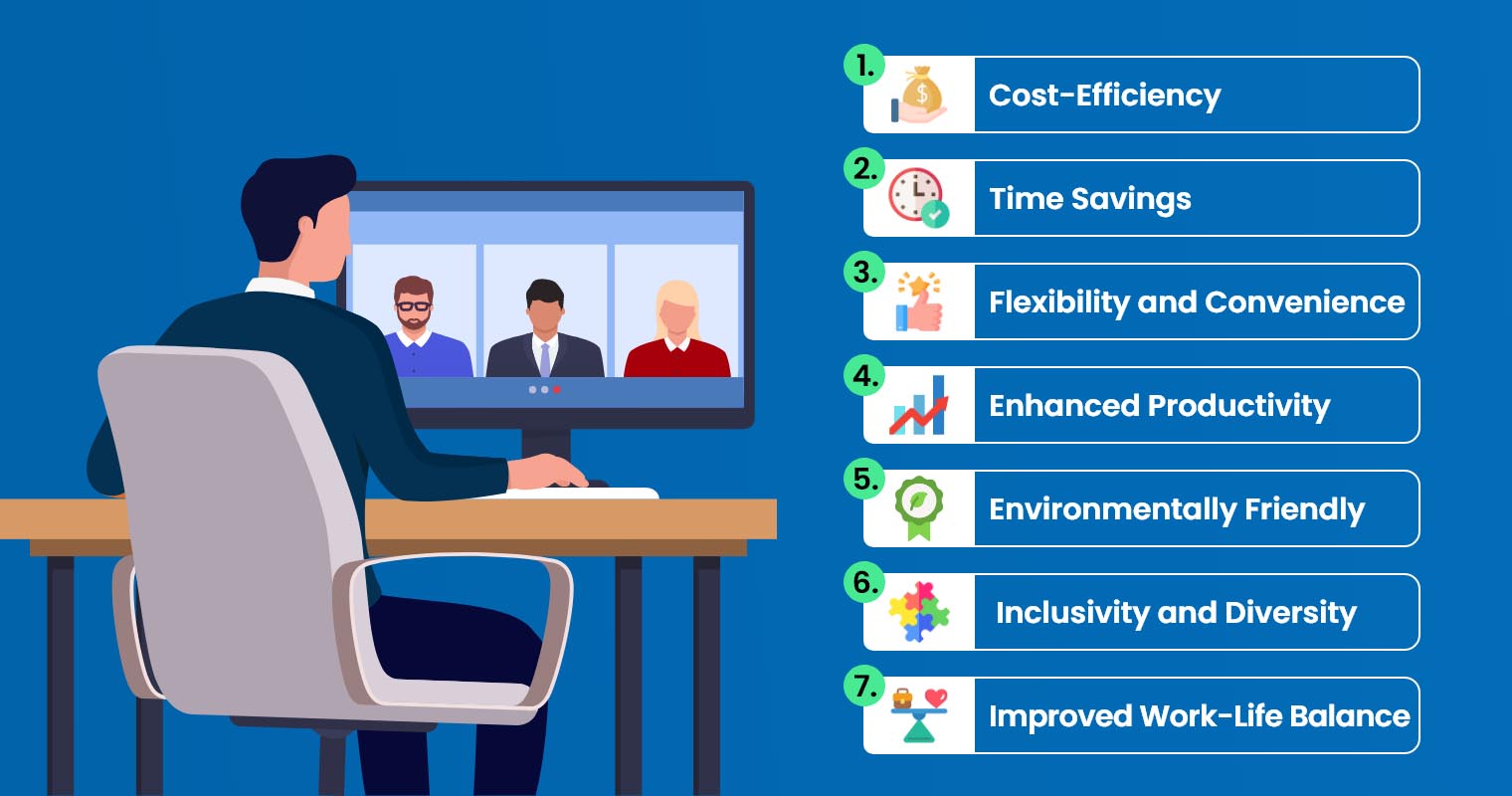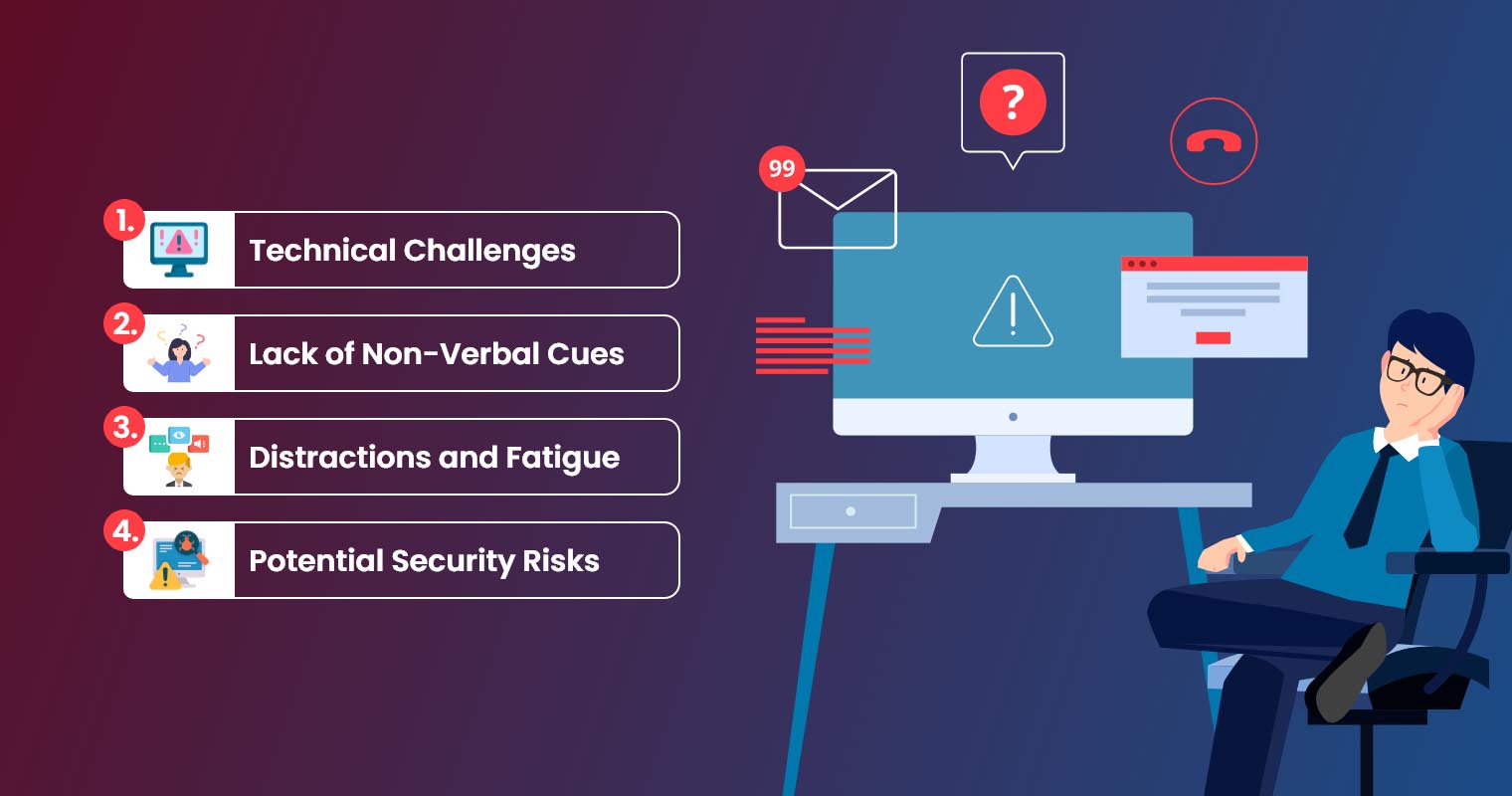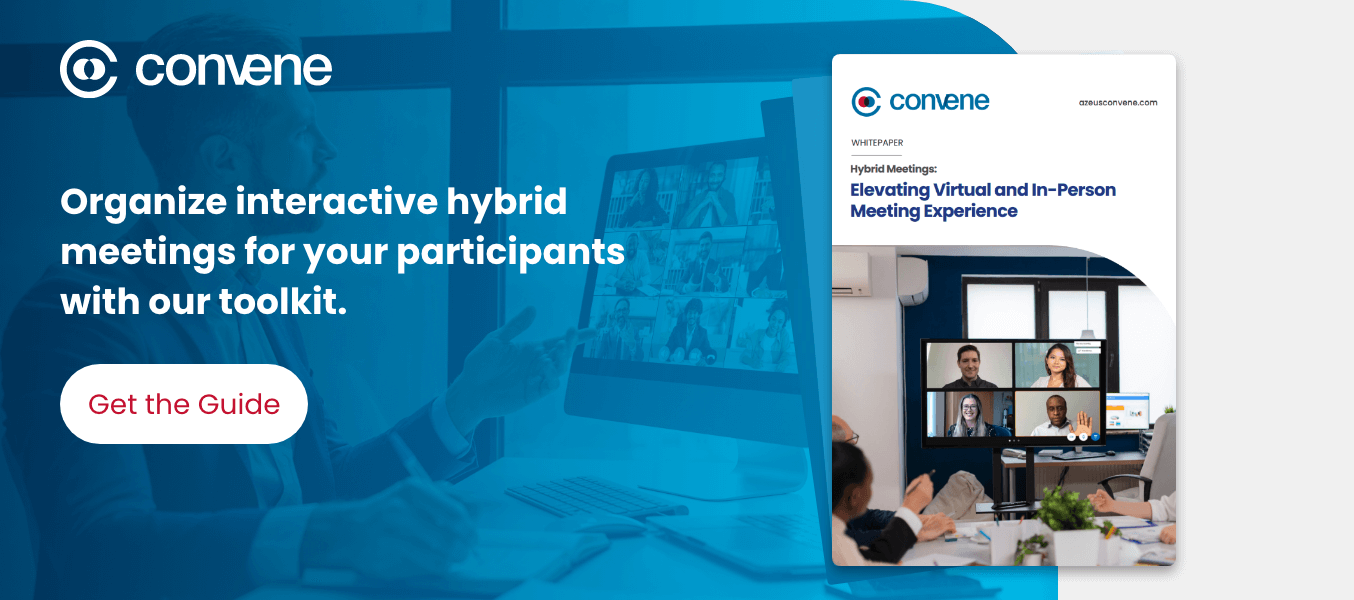The emergence of virtual meetings as a prevailing business norm brings forth an indispensable value. In 2022, the value of the global video conferencing market reached up to $7.02 billion, which serves as compelling evidence of their lasting impact. While they may not entirely resolve the challenges of meeting culture, they do offer numerous advantages surpassing traditional in-office gatherings.
Virtual meetings offer transformative changes in meeting dynamics and collaboration structures, making them a vital tool in the modern business landscape. The global video conferencing market size is projected to reach $17.05 billion by 2030.
In the next sections, you will learn more about the virtual meetings’ pros and cons, and some FAQs to help you run a successful virtual meeting.
What is a virtual meeting?
A virtual meeting is a real-time interaction among participants, facilitated through digital communication tools. The meaning of virtual meeting lies in its ability to allow individuals to connect and collaborate remotely, regardless of their physical locations. Through video conferencing, audio calls, and shared screens, they foster effective communication in a convenient and accessible manner.
The real meaning of effective virtual meetings often relies on picking the right technologies to enhance engagement and productivity. These may include web conferencing software, chat functions, and collaborative tools. These meetings bridge geographical gaps, but to be successful, they also require good internet connectivity, clear communication, and adherence to proper meeting etiquette.
What are the types of virtual meetings?
Virtual meetings have revolutionized the way people communicate and collaborate, providing efficient alternatives to traditional in-person gatherings. Four main types of virtual board meetings have emerged, each catering to different needs. Find out about them below:
- Video Conferencing — This enables real-time audio and video communication between multiple participants located in different places. It typically involves the use of webcams, microphones, and internet-connected devices. Video conferencing allows participants to see and hear each other, fostering a more interactive experience compared to traditional audio-only conferencing.
- Web Conferencing — This type encompasses various online communication and collaboration tools. It utilizes features like screen sharing, document sharing, chat functions, and virtual whiteboards, enabling participants to conduct presentations and hold discussions in real-time.
- Webinars — Webinars, short for web seminars, are virtual meetings conducted over the internet, usually in a one-to-many format. They involve a presenter or a panel of speakers delivering a presentation, lecture, or workshop to an audience of attendees. Webinars often include interactive elements like Q&A sessions or polls, allowing participants to engage with the content and the presenter.
- Teleconferencing — Also known as audio conferencing, this involves multiple participants connecting over the telephone or VoIP (Voice over Internet Protocol). While it lacks visual components like video conferencing, teleconferencing remains a cost-effective way to facilitate discussions, especially when face-to-face interactions are not necessary or feasible.
From the immersive face-to-face interactions facilitated by video conferencing to the seamless collaboration enabled by web conferencing tools, each type offers distinct advantages for efficient virtual interactions. By understanding the various meeting types, organizations can choose the most suitable format for their specific communication needs.
The Advantages of Virtual Meetings

Across borders and time zones, virtual meetings empower businesses and people to connect effortlessly — transcending geographical constraints. Undoubtedly, these meetings offer a multitude of advantages that have transformed modern communication. Find out the benefits of virtual meetings below.
1. Cost-Efficiency
One of the benefits of virtual meetings is their cost-effectiveness. Organizations can significantly reduce expenses associated with travel, accommodation, and venue rentals. By conducting meetings online, companies can allocate resources more efficiently, directing saved funds toward other critical business aspects.
For instance, enterprises can save substantial amounts by avoiding frequent business trips for their employees. On the other hand, startups can make the most of their limited budgets by utilizing virtual meeting platforms instead of renting out-of-budget conference rooms.
2. Time Savings
Virtual meetings can save valuable time for all participants involved. Commuting to physical meeting locations can consume considerable hours, especially when dealing with long distances or congested traffic. With virtual meetings, people can log in from their offices, homes, or any convenient spot, eliminating travel time. This time-saving aspect translates into enhanced productivity and allows professionals to focus more on essential tasks and responsibilities.
3. Flexibility and Convenience
Among the advantages of virtual meetings is that it offers unparalleled flexibility and convenience for attendees. With no geographical boundaries, participants can join meetings from different time zones, making it easier to accommodate global teams and international clients. They can choose the most suitable environment for their engagement, enhancing their comfort and concentration during the meeting.
4. Enhanced Productivity
Through collaboration tools and shared screen functionalities, virtual meetings facilitate seamless information exchange and idea sharing. This promotes more focused discussions, quicker decision-making, and smoother project workflows. For example, a design team working on a project can use screen-sharing to review and provide real-time feedback on design mock-ups, leading to faster iterations and ultimately, expediting the project’s completion.
5. Environmentally Friendly
Emphasizing virtual meetings aligns with eco-conscious practices, as they significantly reduce carbon footprint associated with traditional business travel. The environmental impact of lessened travel includes decreased greenhouse gas emissions, reduced energy consumption, and less waste generation. By adopting virtual meetings, organizations can demonstrate their commitment to sustainability and contribute to a greener planet.
6. Inclusivity and Diversity
Virtual meetings promote inclusivity by breaking down barriers to physical accessibility. Participants with disabilities or limited mobility can easily attend virtual meetings without facing the challenges of accessing physical meeting spaces. Moreover, diverse teams from different cultural backgrounds and locations can collaborate more effectively, enriching discussions with varied perspectives.
7. Improved Work-Life Balance
Virtual meetings enable professionals to strike a healthier balance between their personal and work lives. By reducing the need for travel and facilitating remote work, individuals can better manage their time, leading to reduced stress and burnout. This work-life balance not only enhances overall well-being but also contributes to higher job satisfaction and employee retention.
The Disadvantages of Virtual Meetings

Virtual meetings have emerged as a cornerstone of modern communication. While undeniably beneficial, it is essential to acknowledge the challenges that come with such meetings. This section explores the disadvantages of virtual meetings, from the technical to communicative aspects.
1. Technical Challenges
Virtual meetings, reliant on internet connectivity and communication tools, are susceptible to various technical challenges. Participants may encounter issues such as unstable connections, audio/video synchronization problems, or software compatibility glitches. These issues can disrupt the flow of discussions, impede effective communication, and create frustration among attendees.
2. Lack of Non-Verbal Cues
Unlike face-to-face interactions, virtual meetings lack the full range of non-verbal cues, such as body language, facial expressions, and eye contact. This limitation can hinder participants’ ability to interpret emotions, attitudes, and intentions accurately. Subtle cues that aid in understanding context and building rapport may be lost, potentially leading to miscommunications and misunderstandings.
3. Distractions and Fatigue
Virtual meetings take place in diverse settings, often beyond the controlled environment of a conference room. Participants may face distractions from household activities, phone notifications, or multitasking on other work tasks. As a result, attention and engagement may be compromised, affecting the overall quality of the meeting.
Moreover, constantly attending back-to-back online sessions can be mentally and emotionally draining for participants, leading to meeting fatigue. The strain of screen time, prolonged concentration, and limited physical movement can result in reduced attentiveness, diminished productivity, and increased stress levels among employees.
4. Potential Security Risks
Virtual meetings come with inherent security risks, especially when conducted through third-party platforms or when sensitive information is shared. Unauthorized access to meetings, data breaches, or phishing attempts are some of the potential security concerns. Organizations need to implement robust security measures, such as using secure meeting links and encrypted communication, to mitigate these risks effectively.
Frequently Asked Questions About Virtual Meetings
Ensuring efficient virtual meetings is paramount in maximizing productivity and collaboration in a remote work environment. In this section, we will address the common questions about virtual meetings, helping you ensure efficiency and engagement.
How can I ensure a successful virtual meeting?
To ensure a successful virtual meeting, it’s essential to create a well-structured agenda with clear objectives. Test the technical setup beforehand to avoid interruptions. Encourage active participation by involving all attendees and fostering an inclusive environment. Establish ground rules for respectful communication and time management to keep the meeting focused and productive.
What are some strategies to overcome technical challenges in virtual meetings?
Some of the best practices to overcome technical challenges in virtual meetings are:
- Prioritizing reliable internet connections and considering backup communication methods in case of disruptions.
- Keeping software and applications updated to ensure smooth operation.
- Conducting test runs to address any technical issues proactively and minimize interruptions during the actual session.
How can virtual meetings impact team collaboration?
Virtual meetings significantly impact team collaboration by breaking down geographical barriers and allowing global teams to work together effectively. They facilitate real-time communication and idea sharing, leading to faster decision-making and streamlined project workflows. The ability to collaborate remotely fosters a sense of inclusivity, promoting a diverse and dynamic team environment.
Are there any security measures to protect sensitive information during virtual meetings?
Organizations can ensure the safety of their virtual meetings and sensitive information by leveraging advanced security features available in virtual meeting platforms like board meeting software. Key security measures include implementing secure meeting links, using encryption for data transmission, enabling password protection, and restricting participant access. By employing trusted virtual meeting platforms, organizations can fortify the confidentiality of their virtual meetings and safeguard critical information effectively.
What are some creative ways to keep participants engaged in virtual meetings?
Here are some creative ways to keep your meeting participants engaged:
- Employ interactive tools like polls and quizzes to encourage active participation
- Utilize breakout sessions for smaller group discussions to promote collaboration and idea exchange
- Incorporate visual aids like slides, videos, or interactive whiteboards to enhance presentations and maintain interest.
- Encourage open discussions and consider rotating meeting roles to keep attendees invested and motivated throughout the session.
What are the best practices for following up after virtual meetings?
Following up after virtual meetings is essential to ensure effective outcomes. Do so by distributing meeting minutes or summaries promptly to all participants, outlining action items and responsibilities. You can also conduct progress check-ins to track the status of tasks and goals. Also, encourage open communication and provide avenues for feedback to address concerns that may arise post-meeting.
Convene: Your Go-to Board Meeting Software

Amidst the dynamic evolution of modern communication, virtual meetings are reshaping traditional paradigms and ushering in unparalleled efficiency for businesses. Embracing this transformative shift, forward-thinking companies are wholeheartedly embracing virtual board meeting software.
Convene, one of today’s top board meeting software, offers powerful features to optimize collaboration, productivity, and decision-making. This user-friendly solution streamlines meeting processes — reducing preparation time and freeing up resources for value-adding projects. By providing full-system ownership, Convene ensures total control over user management and permissions, safeguarding confidential board materials. Some of Convene’s features that you can experience are:
- Powerful Meeting and Presentation Tools: Elevate boardroom performance with live meeting tools such as Shared Annotations, Laser Pointer Tool, and Page Synchronization, enhancing collaboration and productivity during virtual meetings.
- Voting and Resolutions: Review, annotate, and make decisions anytime, anywhere, on any platform, whether iOS, Android, Mac, or Windows, providing flexibility and efficiency in virtual decision-making processes.
- Action Items and Audit Trail: Promote transparency and accountability with Convene’s comprehensive monitoring of deliverables and activities, facilitating a culture of responsibility within the application and admin portal.
- User-Friendly and Intuitive Interface: Designed for directors and secretaries, Convene’s intuitive interface ensures ease of use, allowing users to master its functions within 30 minutes. Additionally, unlimited training and 24/7/365 global support are available for any assistance.
- Top-Notch Security: Convene adheres to industry-leading security standards, ensuring board confidentiality and regulatory compliance. Leveraging cutting-edge technology, Convene protects against potential threats, guaranteeing the security, availability, and integrity of the system.
Discover the power of Convene and experience seamless virtual meetings for your organization. Book a demo today!
Jielynne is a Content Marketing Writer at Convene. With over six years of professional writing experience, she has worked with several SEO and digital marketing agencies, both local and international. She strives in crafting clear marketing copies and creative content for various platforms of Convene, such as the website and social media. Jielynne displays a decided lack of knowledge about football and calculus, but proudly aces in literary arts and corporate governance.











